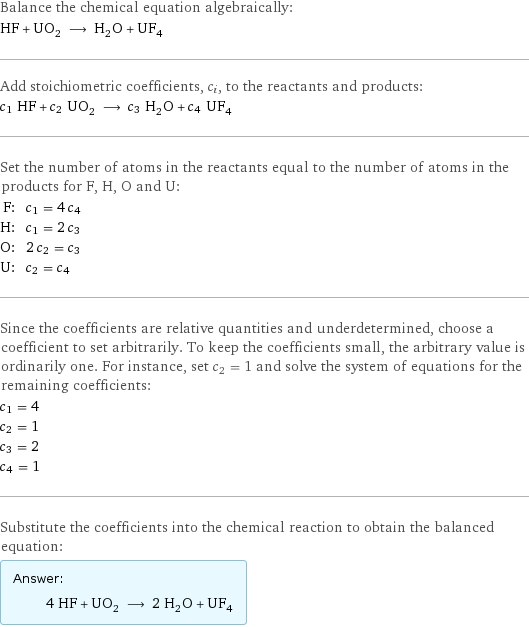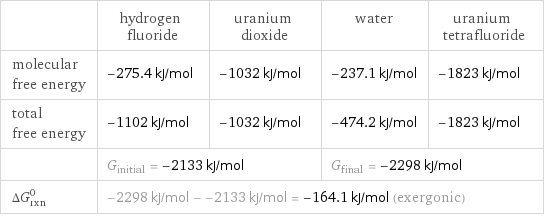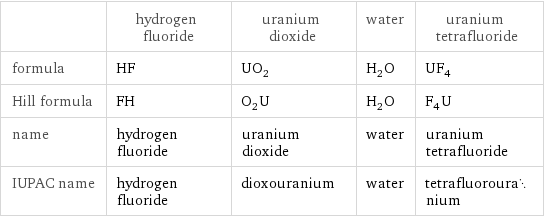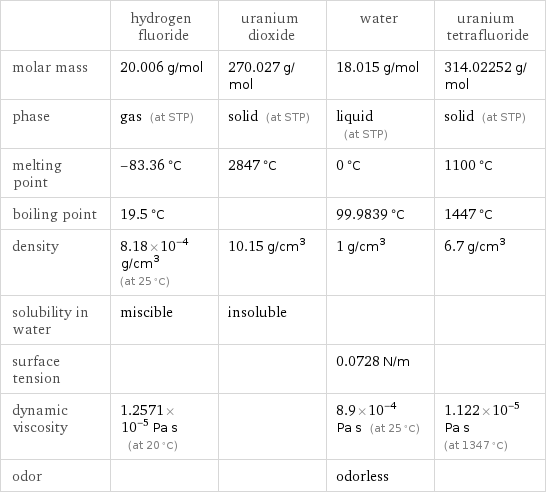Input interpretation

HF hydrogen fluoride + UO_2 uranium dioxide ⟶ H_2O water + UF_4 uranium tetrafluoride
Balanced equation

Balance the chemical equation algebraically: HF + UO_2 ⟶ H_2O + UF_4 Add stoichiometric coefficients, c_i, to the reactants and products: c_1 HF + c_2 UO_2 ⟶ c_3 H_2O + c_4 UF_4 Set the number of atoms in the reactants equal to the number of atoms in the products for F, H, O and U: F: | c_1 = 4 c_4 H: | c_1 = 2 c_3 O: | 2 c_2 = c_3 U: | c_2 = c_4 Since the coefficients are relative quantities and underdetermined, choose a coefficient to set arbitrarily. To keep the coefficients small, the arbitrary value is ordinarily one. For instance, set c_2 = 1 and solve the system of equations for the remaining coefficients: c_1 = 4 c_2 = 1 c_3 = 2 c_4 = 1 Substitute the coefficients into the chemical reaction to obtain the balanced equation: Answer: | | 4 HF + UO_2 ⟶ 2 H_2O + UF_4
Structures

+ ⟶ +
Names

hydrogen fluoride + uranium dioxide ⟶ water + uranium tetrafluoride
Reaction thermodynamics
Enthalpy

| hydrogen fluoride | uranium dioxide | water | uranium tetrafluoride molecular enthalpy | -273.3 kJ/mol | -1085 kJ/mol | -285.8 kJ/mol | -1914 kJ/mol total enthalpy | -1093 kJ/mol | -1085 kJ/mol | -571.7 kJ/mol | -1914 kJ/mol | H_initial = -2178 kJ/mol | | H_final = -2486 kJ/mol | ΔH_rxn^0 | -2486 kJ/mol - -2178 kJ/mol = -307.7 kJ/mol (exothermic) | | |
Gibbs free energy

| hydrogen fluoride | uranium dioxide | water | uranium tetrafluoride molecular free energy | -275.4 kJ/mol | -1032 kJ/mol | -237.1 kJ/mol | -1823 kJ/mol total free energy | -1102 kJ/mol | -1032 kJ/mol | -474.2 kJ/mol | -1823 kJ/mol | G_initial = -2133 kJ/mol | | G_final = -2298 kJ/mol | ΔG_rxn^0 | -2298 kJ/mol - -2133 kJ/mol = -164.1 kJ/mol (exergonic) | | |
Equilibrium constant
![Construct the equilibrium constant, K, expression for: HF + UO_2 ⟶ H_2O + UF_4 Plan: • Balance the chemical equation. • Determine the stoichiometric numbers. • Assemble the activity expression for each chemical species. • Use the activity expressions to build the equilibrium constant expression. Write the balanced chemical equation: 4 HF + UO_2 ⟶ 2 H_2O + UF_4 Assign stoichiometric numbers, ν_i, using the stoichiometric coefficients, c_i, from the balanced chemical equation in the following manner: ν_i = -c_i for reactants and ν_i = c_i for products: chemical species | c_i | ν_i HF | 4 | -4 UO_2 | 1 | -1 H_2O | 2 | 2 UF_4 | 1 | 1 Assemble the activity expressions accounting for the state of matter and ν_i: chemical species | c_i | ν_i | activity expression HF | 4 | -4 | ([HF])^(-4) UO_2 | 1 | -1 | ([O2U])^(-1) H_2O | 2 | 2 | ([H2O])^2 UF_4 | 1 | 1 | [UF4] The equilibrium constant symbol in the concentration basis is: K_c Mulitply the activity expressions to arrive at the K_c expression: Answer: | | K_c = ([HF])^(-4) ([O2U])^(-1) ([H2O])^2 [UF4] = (([H2O])^2 [UF4])/(([HF])^4 [O2U])](../image_source/5ef0eee15c8fb51b88b4c769d7610e91.png)
Construct the equilibrium constant, K, expression for: HF + UO_2 ⟶ H_2O + UF_4 Plan: • Balance the chemical equation. • Determine the stoichiometric numbers. • Assemble the activity expression for each chemical species. • Use the activity expressions to build the equilibrium constant expression. Write the balanced chemical equation: 4 HF + UO_2 ⟶ 2 H_2O + UF_4 Assign stoichiometric numbers, ν_i, using the stoichiometric coefficients, c_i, from the balanced chemical equation in the following manner: ν_i = -c_i for reactants and ν_i = c_i for products: chemical species | c_i | ν_i HF | 4 | -4 UO_2 | 1 | -1 H_2O | 2 | 2 UF_4 | 1 | 1 Assemble the activity expressions accounting for the state of matter and ν_i: chemical species | c_i | ν_i | activity expression HF | 4 | -4 | ([HF])^(-4) UO_2 | 1 | -1 | ([O2U])^(-1) H_2O | 2 | 2 | ([H2O])^2 UF_4 | 1 | 1 | [UF4] The equilibrium constant symbol in the concentration basis is: K_c Mulitply the activity expressions to arrive at the K_c expression: Answer: | | K_c = ([HF])^(-4) ([O2U])^(-1) ([H2O])^2 [UF4] = (([H2O])^2 [UF4])/(([HF])^4 [O2U])
Rate of reaction
![Construct the rate of reaction expression for: HF + UO_2 ⟶ H_2O + UF_4 Plan: • Balance the chemical equation. • Determine the stoichiometric numbers. • Assemble the rate term for each chemical species. • Write the rate of reaction expression. Write the balanced chemical equation: 4 HF + UO_2 ⟶ 2 H_2O + UF_4 Assign stoichiometric numbers, ν_i, using the stoichiometric coefficients, c_i, from the balanced chemical equation in the following manner: ν_i = -c_i for reactants and ν_i = c_i for products: chemical species | c_i | ν_i HF | 4 | -4 UO_2 | 1 | -1 H_2O | 2 | 2 UF_4 | 1 | 1 The rate term for each chemical species, B_i, is 1/ν_i(Δ[B_i])/(Δt) where [B_i] is the amount concentration and t is time: chemical species | c_i | ν_i | rate term HF | 4 | -4 | -1/4 (Δ[HF])/(Δt) UO_2 | 1 | -1 | -(Δ[O2U])/(Δt) H_2O | 2 | 2 | 1/2 (Δ[H2O])/(Δt) UF_4 | 1 | 1 | (Δ[UF4])/(Δt) (for infinitesimal rate of change, replace Δ with d) Set the rate terms equal to each other to arrive at the rate expression: Answer: | | rate = -1/4 (Δ[HF])/(Δt) = -(Δ[O2U])/(Δt) = 1/2 (Δ[H2O])/(Δt) = (Δ[UF4])/(Δt) (assuming constant volume and no accumulation of intermediates or side products)](../image_source/8bc49feeff35f7ddb22a2fd2676798b8.png)
Construct the rate of reaction expression for: HF + UO_2 ⟶ H_2O + UF_4 Plan: • Balance the chemical equation. • Determine the stoichiometric numbers. • Assemble the rate term for each chemical species. • Write the rate of reaction expression. Write the balanced chemical equation: 4 HF + UO_2 ⟶ 2 H_2O + UF_4 Assign stoichiometric numbers, ν_i, using the stoichiometric coefficients, c_i, from the balanced chemical equation in the following manner: ν_i = -c_i for reactants and ν_i = c_i for products: chemical species | c_i | ν_i HF | 4 | -4 UO_2 | 1 | -1 H_2O | 2 | 2 UF_4 | 1 | 1 The rate term for each chemical species, B_i, is 1/ν_i(Δ[B_i])/(Δt) where [B_i] is the amount concentration and t is time: chemical species | c_i | ν_i | rate term HF | 4 | -4 | -1/4 (Δ[HF])/(Δt) UO_2 | 1 | -1 | -(Δ[O2U])/(Δt) H_2O | 2 | 2 | 1/2 (Δ[H2O])/(Δt) UF_4 | 1 | 1 | (Δ[UF4])/(Δt) (for infinitesimal rate of change, replace Δ with d) Set the rate terms equal to each other to arrive at the rate expression: Answer: | | rate = -1/4 (Δ[HF])/(Δt) = -(Δ[O2U])/(Δt) = 1/2 (Δ[H2O])/(Δt) = (Δ[UF4])/(Δt) (assuming constant volume and no accumulation of intermediates or side products)
Chemical names and formulas

| hydrogen fluoride | uranium dioxide | water | uranium tetrafluoride formula | HF | UO_2 | H_2O | UF_4 Hill formula | FH | O_2U | H_2O | F_4U name | hydrogen fluoride | uranium dioxide | water | uranium tetrafluoride IUPAC name | hydrogen fluoride | dioxouranium | water | tetrafluorouranium
Substance properties

| hydrogen fluoride | uranium dioxide | water | uranium tetrafluoride molar mass | 20.006 g/mol | 270.027 g/mol | 18.015 g/mol | 314.02252 g/mol phase | gas (at STP) | solid (at STP) | liquid (at STP) | solid (at STP) melting point | -83.36 °C | 2847 °C | 0 °C | 1100 °C boiling point | 19.5 °C | | 99.9839 °C | 1447 °C density | 8.18×10^-4 g/cm^3 (at 25 °C) | 10.15 g/cm^3 | 1 g/cm^3 | 6.7 g/cm^3 solubility in water | miscible | insoluble | | surface tension | | | 0.0728 N/m | dynamic viscosity | 1.2571×10^-5 Pa s (at 20 °C) | | 8.9×10^-4 Pa s (at 25 °C) | 1.122×10^-5 Pa s (at 1347 °C) odor | | | odorless |
Units
